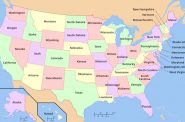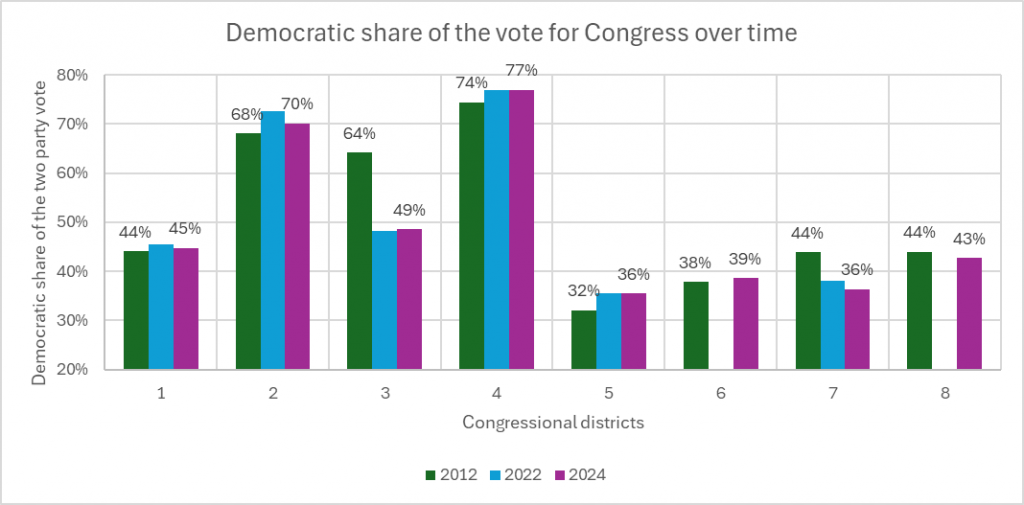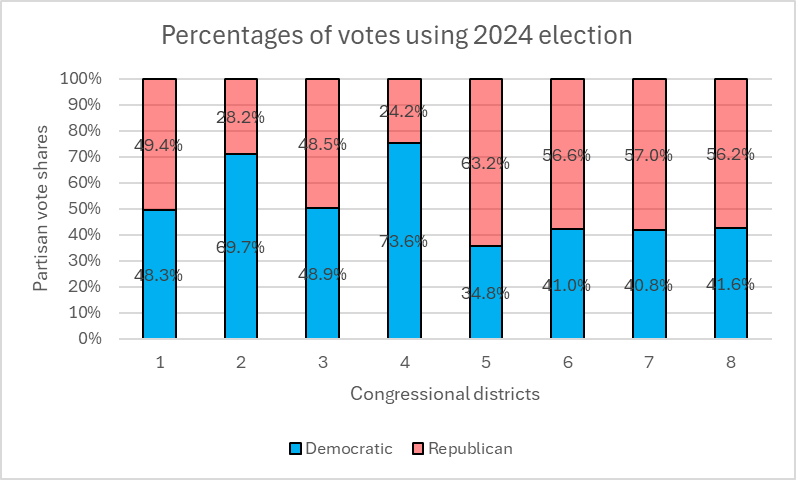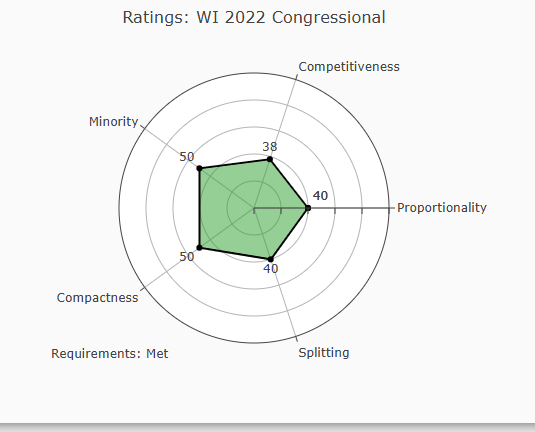Can New Legal Challenge Reshape State’s Congressional Districts?
Can more competitive districts be created and what would they look like?
A recent submission to Wisconsin’s courts introduced a new issue to redistricting Wisconsin’s congressional delegation. The group bringing the challenge, Wisconsin Business Leaders for Democracy (WBLD), asserts that the districts’ designers were motivated to protect incumbents from challenges by candidates from the other party.
WBLD is represented by Law Forward, along with counsel at Stafford Rosenbaum LLP and the Election Law Clinic at Harvard Law School. They argue that:
Wisconsin’s current congressional plan presents a textbook example of an anti‐competitive gerrymander. … Anti‐competitive gerrymanders are every bit as antithetical to democracy, and to law, as partisan gerrymanders and racial gerrymanders.
In their request for a three-judge panel, lawyers for Wisconsin Business Leaders argue that the problem started with the passage of Act 44 in 2011, following the 2010 Census. Governor Scott Walker and Republican state legislators took advantage of the Republican “trifecta” which gave them control of the state Senate and Assembly as well as the governorship. This allowed them to install a district plan that heavily favored incumbents, who happened to be mostly Republican.
When it came time to update the legislative maps, the Supreme Court adopted a “least change” criterion, essentially perpetuating Act 44. With the election of a new Supreme Court justice, the state Assembly and Senate maps were made less gerrymandered. However, the congressional district map was left unchanged.
Wisconsin Business Leaders’ submissions point to Act 44’s success in making sure incumbents are re-elected:
Across the forty individual district races held under Act 44, the median margin of victory was more than twenty‐five percentage points—a blowout by any measure. Only one of these forty races was decided by a margin of fewer than ten percentage points.
They conclude that:
Wisconsin’s current congressional map thus perpetuates the anti‐competitive gerrymander imposed in 2011.
In their view, an anti‐competitive gerrymander occurs when:
… elected officials work in concert to draw district lines to suppress electoral competition, thereby benefiting incumbent politicians to the detriment of voters.
They argue that anti‐competitive gerrymandering is distinct from partisan gerrymandering, which draws district lines to pack members of the disfavored party into a small number of districts, thus unfairly boosting the number of seats won by the favored party. Anti‐competitive gerrymandering is also distinct from racial gerrymandering.
Given this record, it is not surprising that in 2022 no Democrat chose to contest District 6 or District 8. Clearly, the authors of the Wisconsin Congressional map were not interested in encouraging competition.
Dave’s Redistricting App (DRA) is an online tool allowing users to create, view, analyze, and share redistricting maps for U.S. congressional and legislative districts. It aims to empower citizens by making the redistricting process more transparent and accessible, helping to combat gerrymandering.
The next graph, drawn using DRA, maps today’s Congressional districts. Districts 2 and 4 are heavily Democratic, based as they are on the state’s two largest cities, Madison and Milwaukee. Districts five to eight are overwhelmingly Republican. Of the eight districts, only district one and three can be considered competitive, although both are currently Republican.
This pattern is confirmed in the next graph showing the percentage of the vote that went to each party in the 2024 election.
If the Wisconsin Business Leaders are successful in their challenge, what might the replacement look like? According to DRA’s analysis, the most competitive map of those submitted for Wisconsin’s congressional districts is called “muffintime’s Competitive Wisconsin.”
The next graph shows the competitiveness of each of the eight districts generated by the muffintime map. Six of the eight districts are almost perfectly competitive. In fact, none of the winners in those six districts won the majority of the votes, only a plurality when write-in votes are included.
Even in the two districts that favored one party over the other— Democrats in District 2 and Republicans in District 8—are more competitive than the six uncompetitive districts in the current map.
How does muffintime get there? The next map suggests one factor: a willingness to split Milwaukee among four different districts.
This is shown in more detail in the next graph. In fact, Milwaukee is shared by four districts, districts one, four, five, and six. Half of the Wisconsin congressional delegation would include Milwaukee residents. This may trouble those who believe that districts should share a community of common interests.
In addition, having representatives concerned about the needs of urban and of rural dwellers could be a healthy trend if it encouraged politicians to look for policies that served a wide range of constituents, perhaps helping to counter the present trends of people clustering in like-minded groups.
For each district map submitted, DRA calculated how it rated using five dimensions: proportionality, competitiveness, minority, compactness, and splitting across counties. In this analysis, higher scores meant better scores. The next graph shows scores earned by the current maps. All five ratings are mediocre.
By contrast, the next graph shows the five scores earned by muffintime’s Competitive Wisconsin. Its scores for competitiveness, proportionality, and splitting were far superior to the same scores for the existing map. The other two scores were slightly worse than for the current map, but only by a small amount.
No attempt is made here to show that the muffintime’s map was the best of all possible maps for Wisconsin’s congressional delegation. However, its obvious superiority to the current long-time map should be a sign that better and more democratic maps are possible. Competition is good for democracy.
If you think stories like this are important, become a member of Urban Milwaukee and help support real, independent journalism. Plus you get some cool added benefits.
Data Wonk
-
Life Expectancy in Wisconsin vs. Other States
 Dec 10th, 2025 by Bruce Thompson
Dec 10th, 2025 by Bruce Thompson
-
How Republicans Opened the Door To Redistricting
 Nov 26th, 2025 by Bruce Thompson
Nov 26th, 2025 by Bruce Thompson
-
The Connection Between Life Expectancy, Poverty and Partisanship
 Nov 21st, 2025 by Bruce Thompson
Nov 21st, 2025 by Bruce Thompson


























